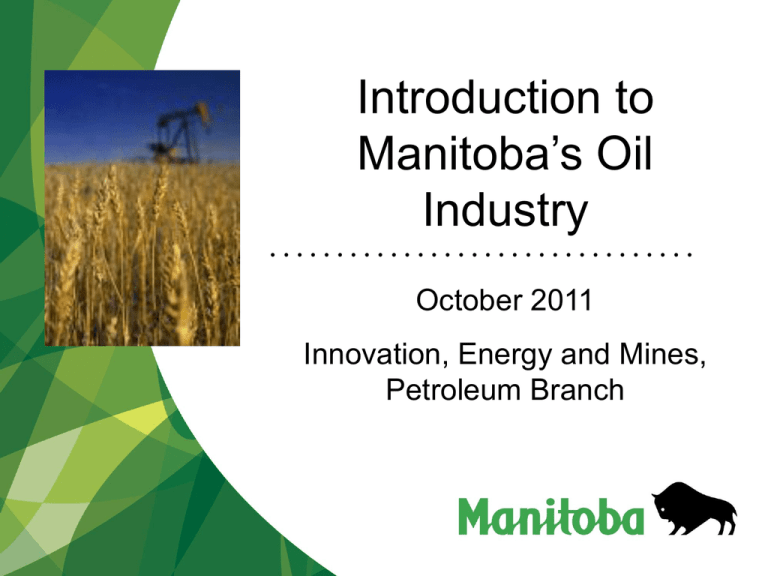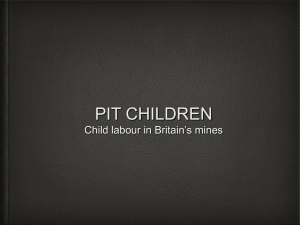Introduction to Manitoba`s Oil Industry PowerPoint
advertisement

Introduction to Manitoba’s Oil Industry • • • • • • • • • • • • • • • • • • • • • • • • • • • • • • • • October 2011 Innovation, Energy and Mines, Petroleum Branch what is petroleum? • Crude oil, or petroleum, is an organic substance derived from the remains of prehistoric plant and animal remains. – Also known as fossil fuels. • Hydrocarbons are molecules containing hydrogen and carbon. + = ? Plankton • • • • • • • • • • • • • • Innovation, Energy and Mines how was oil formed? Crude oil was formed from the remains of dead sea creatures and plants (plankton). The organic material remains gathered on the seabed and were gradually covered by layers of sand and other sediments. Over time these layers were compressed under the weight of sediments laid on top. The increased pressure and temperature changed the organic material, sand and other sediments into rock. The sand became sandstones or potential reservoir rocks. The organic rich layers became oil and shale or oil source rocks. (Please see animation at http://www.absorblearning.com/media/item.action?quick=11h) • • • • • • • • • • • • • • Innovation, Energy and Mines where do we find oil in the source rock? • Because oil and gas are lighter than water, they float on top of water. Oil and gas that formed in the source rock deep within the earth floated up through tiny pore spaces in the rock. • Reservoirs contain porous rocks, such as sandstones, that allow fluids to flow through the pore spaces, that is, that are permeable. Does this rock have good porosity? How about permeability? • • • • • • • • • • • • • • Innovation, Energy and Mines • • • • • • • • • • • • • • Innovation, Energy and Mines 3 phases of petroleum Exists as a: • liquid – crude oil • vapor – natural gas • solid – coal – oil sands • • • • • • • • • • • • • • Innovation, Energy and Mines how the oil is found... • • • • • • • • • • • • • • Innovation, Energy and Mines drilling rigs • Drilling rigs use a drill stem and a drill bit to grind down through the overlaying rock to get to the oil and gas below. • Drill rigs run 24 hours a day, 7 days a week. • Cost to drill : (2010 average) – Vertical well ~$450,000 + – Horizontal well ~$937,607 + • • • • • • • • • • • • • • Innovation, Energy and Mines 4 Different drill and completion bits Poly- Crystalline Diamond Bit • • • • • • • • • • • • • • Innovation, Energy and Mines Horizontal Drilling A horizontal well is drilled vertically until the kick off point is reached. At this point the well is angled until it meets the targeted producing formation. The wellbore is then drilled horizontally through this reservoir. Horizontal wells provide for a greater drainage area than a conventional vertical well and therefore are generally more productive. In Manitoba over 90% of the wells drilled are horizontal with 1 well replacing four vertical wells. • • • • • • • • • • • • • • Innovation, Energy and Mines Vertical Drilling A hole drilled vertically into the earth usually cased with metal pipe for the production of oil or gas. Prior to 2006 most wells were drilled vertically but new drilling and completion techniques have made horizontals wells economic • • • • • • • • • • • • • • Innovation, Energy and Mines Directional Drilling The technique of drilling at an angle. These wells are drilled for a number of reasons: to develop an offshore lease from one platform; to reach a zone beneath land where drilling cannot be done (beneath a railroad or lake) Directional Horizontal • • • • • • • • • • • • • • Innovation, Energy and Mines How is a bottle of soda similar to an oil well? • • • • • • • • • • • • • • Innovation, Energy and Mines artificial lift • If the formation does not have enough pressure to push liquids to the surface some type of artificial lift system will have to be put in place. • Types of artificial lift: pumpjacks with bottom hole pumps, submersible pumps and progressive cavity pumps. • • • • • • • • • • • • • • Innovation, Energy and Mines Pumpjack with bottom hole pump The purpose of a pumpjack is to convert circular motion into up and down motion to control and operate the bottom hole pump. • • • • • • • • • • • • • • Innovation, Energy and Mines so now what? • Okay, the fluid is to surface, now what? – Is it a saleable product? – Can you put this fluid directly into your car? – What actually comes out of the ground? • • • • • • • • • • • • • • Innovation, Energy and Mines emulsion • Did you know that oil and water really do mix? Emulsion after being shaken Less than 1 minute later •Emulsion is a mixture of oil, water and gas. • • • • • • • • • • • • • • Innovation, Energy and Mines what is a battery? • If you’re thinking Duracell™ or Energizer ™ you are way off! ? • • • • • • • • • • • • • • Innovation, Energy and Mines battery • "battery" means a system or arrangement of tanks or other surface equipment that receives fluid from, or delivers fluid to, one or more wells, and includes an injection plant, a pump station and equipment or a device designed to separate the fluid into oil, gas and water and to measure the amount of oil, gas and water; The Oil and Gas Act Tundra Sinclair 3-4-8-29 WPM Battery • • • • • • • • • • • • • • Innovation, Energy and Mines what is done with the oil? • When the crude oil is clean it is ready to be hauled to a pipeline and sold. Sales shipping line Enbridge pipeline tank farm outside Cromer, MB • • • • • • • • • • • • • • Innovation, Energy and Mines what is done with the water? • The water that is separated out of the emulsion is salt water, also called brine. • Extreme care must be given to its disposal. • Salt water is re-injected into the formation, which helps restore the reservoir pressures. The re-injection process is also called waterflood or secondary recovery. • • • • • • • • • • • • • • Innovation, Energy and Mines Mineral Rights & Surface Rights Mineral Rights: It is the right of the owner to exploit, mine, and/or produce any or all of the minerals lying below the surface of the property. Crown Mineral Rights – 100% of the mineral ownership belongs to the Crown (Provincial Goverment) Portional Mineral Rights - A Portion of the mineral rights are Crown and a portion are Freehold (private) Freehold Mineral Rights - 100% of the mineral ownership belongs to a private (freehold) owner. Approximately 80% of the mineral rights are owned by private individuals or companies, the remaining 20% are owned by the Crown in the right of Manitoba. • Surface Rights - The landowner owns the surface rights to the land and may or may not also own the minerals. • • • • • • • • • • • • • • Innovation, Energy and Mines Environment The environment consists of everything around us, from our water to our farmland, to the sky above. These are valuable resources and it is in our own best interest to protect our land, water and air. We have to take care of our planet! Companies are required to operate within certain guidelines that restrict how they do business. Each country is responsible for its own regulations on what is allowable. • • • • • • • • • • • • • • Innovation, Energy and Mines Rehabilitation • This battery site was rehabilitated and has been brought back to it’s original agricultural state. All oil field infrastructure is to be brought back to it’s original state and is regulated and administered by the Petroleum Branch. • • • • • • • • • • • • • • Innovation, Energy and Mines Safety The Petroleum Branch inspectors are also Workplace Health and Safety officers who are responsible for enforcing a Safe work environment for oil field workers. • • • • • • • • • • • • • • Innovation, Energy and Mines GIS The Petroleum Branch was an early adopter of GIS and a large percentage of employees work with GIS on a daily basis. We use this information to plot Well locations, Oil Pools, Crown owned Mineral Rights, Flow lines, Pipelines, Oil Facilities, calculate royalties paid to Mineral owners, create maps to post Government Lease Sales and much more. The majority of the Oil Industry as a whole across North America uses GIS and therefore has become much easier to view up to date information, make decisions based on location, analyze date and submit information in a digital form. Sample of Crown Leased Mineral Rights • • • • • • • • • • • • • • Innovation, Energy and Mines Daly Sinclair Oil Field Daly and Sinclair Field Consolidation in 2010 For More information on Manitoba’s Oil Fields Please visit www.gov.mb.ca/petroleum or call: Winnipeg: 945-6577 Virden: 748-4260 Waskada: 673-2472








